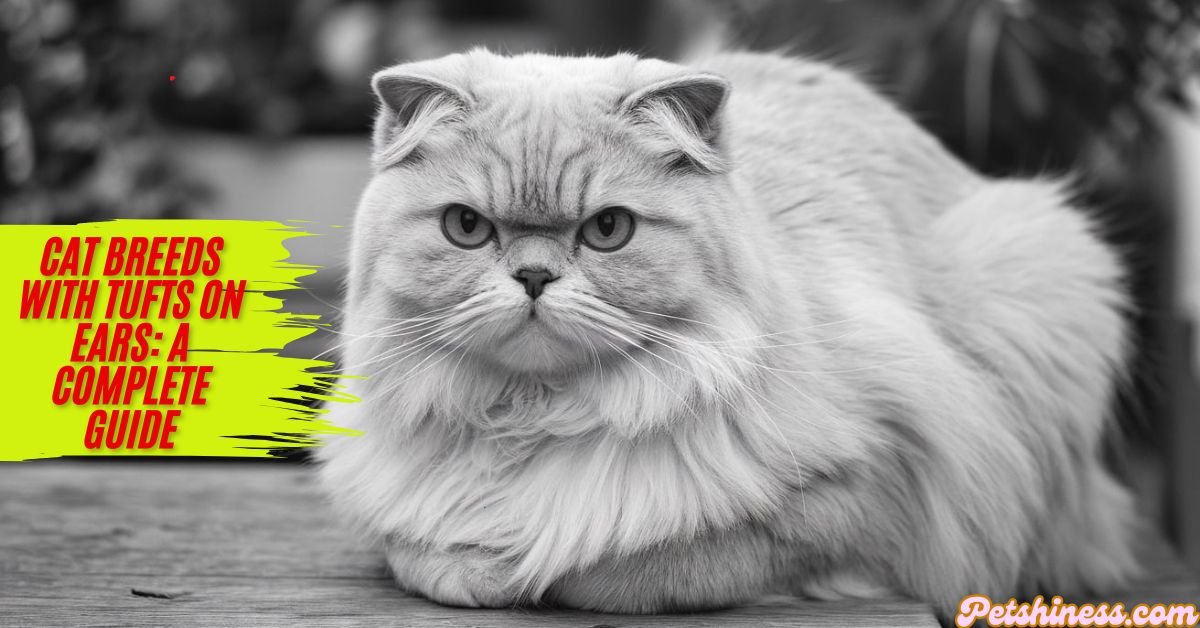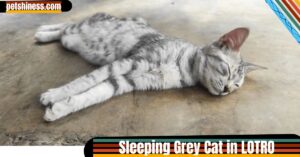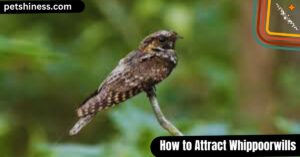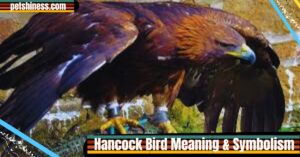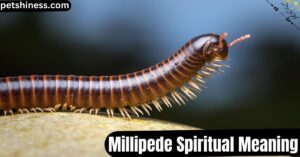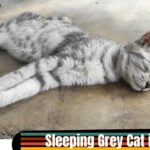Cats with ear tufts are not only beautiful but also unique in their appearance, sparking curiosity among animal lovers. These tufts, often seen in certain domestic and wild cat breeds, add a distinctive charm to their looks. But what exactly are ear tufts, and why do some cats have them?
In this guide, you’ll learn everything about ear tufts, from their purpose to the cat breeds that flaunt them. We’ll explore care tips, fascinating facts, and even how they’ve inspired pop culture. Whether you’re a cat owner, breeder, or enthusiast, this article will answer all your questions.
What Are Ear Tufts and Why Are They Fascinating?
Ear tufts are small, elongated patches of fur growing at the tips of a cat’s ears. Unlike regular fur, these tufts serve specific functions and can vary greatly in size and prominence across breeds. They are not to be confused with ear furnishings, which are the hair inside a cat’s ears.
Why are they fascinating?
- Evolutionary Role: In the wild, ear tufts may assist with camouflage or amplify sound for hunting.
- Aesthetic Appeal: They enhance the regal, wild appearance of domestic cats like the Maine Coon.
- Symbol of Breeding Excellence: Prominent tufts are often prized in shows, making them a marker of superior breeding.
Both domestic and wild cats like the lynx or caracal exhibit these features. In domestic breeds, they add a touch of the wild, making tufted-ear cats stand out in any crowd.
What Are Ear Tufts, and Why Do Cats Have Them?
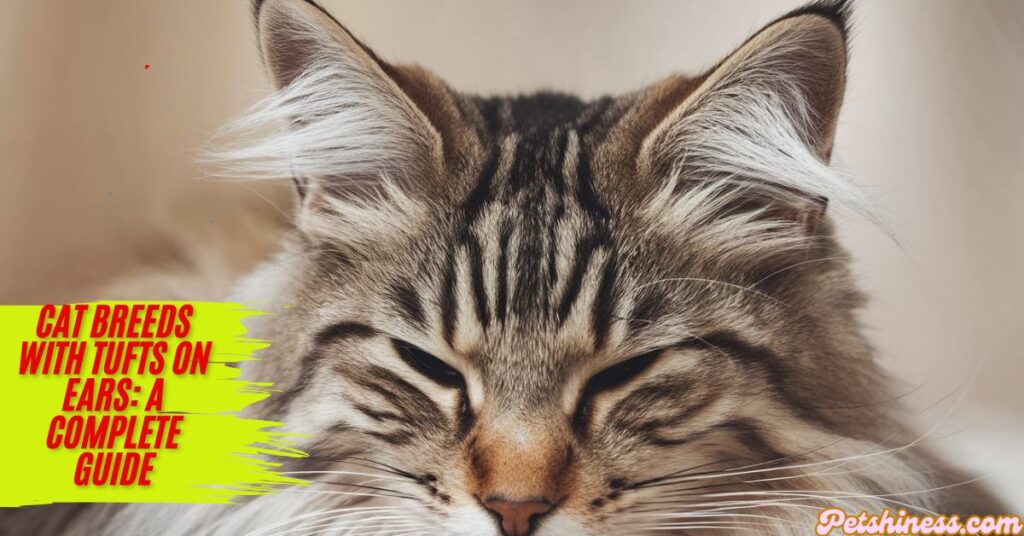
Ear tufts are distinct clumps of fur that grow at the tips of a cat’s ears, often giving them a wild, majestic look. These tufts are different from ear furnishings, which refer to the fine hair inside the ear canal. While ear furnishings help protect a cat’s ear from dirt and debris, ear tufts serve more specialized functions.
Definition of Ear Tufts and How They Differ from Ear Furnishings
- Ear Tufts: These are the longer, more visible strands of fur found on the outside tips of a cat’s ears. They are often straight and protrude slightly, adding a wild or bushy look.
- Ear Furnishings: Unlike tufts, these are the hairs found on the inside of the ear, often soft and less noticeable, which act as a barrier to prevent dirt and moisture from entering the ear canal.
Although ear tufts are primarily a cosmetic feature in domestic cats, they play an important evolutionary role for wild cats.
Evolutionary Purpose: Sound Direction, Protection, or Camouflage in the Wild
In wild cats, ear tufts are believed to serve multiple evolutionary purposes:
- Sound Direction: Tufts can help direct sounds into a cat’s ears, enhancing its ability to hear high-pitched noises, which is crucial for hunting small prey.
- Protection: In some wild species, tufts may offer protection against the elements or predators by acting as a natural defense.
- Camouflage: For wild cats like the lynx and caracal, ear tufts help break up the outline of their heads, aiding in camouflage against predators and prey.
Why Do Some Cats Have Them While Others Don’t?
The presence of ear tufts is a genetic trait that varies by breed. For instance, breeds like the Maine Coon, Norwegian Forest Cat, and Siberian Cat commonly have tufted ears, while other domestic breeds do not. This variation is likely due to selective breeding, with tufts being a desirable feature for aesthetic purposes and sometimes linked to the cat’s ability to adapt to colder climates.
Breeds that naturally live in colder regions may have developed tufts as an evolutionary advantage to protect their ears from the cold or as a way to enhance hearing in dense forests where they hunt. On the other hand, breeds that don’t need this adaptation may lack ear tufts, as they are not essential for their survival.
Domestic Cat Breeds with Tufts on Ears
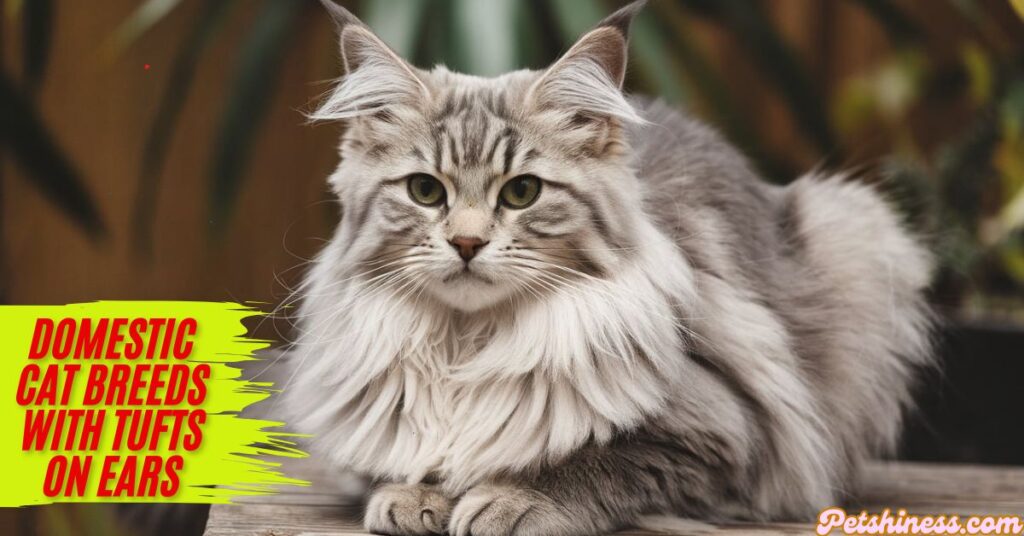
Cats with ear tufts are a striking sight, and these tufts are more than just an aesthetic feature they often represent the breed’s unique history, physical traits, and even its adaptations to the environment. Here’s an overview of some of the top domestic cat breeds with ear tufts, each with its own personality, looks, and care requirements.
Breeds with Ear Tufts
Maine Coon
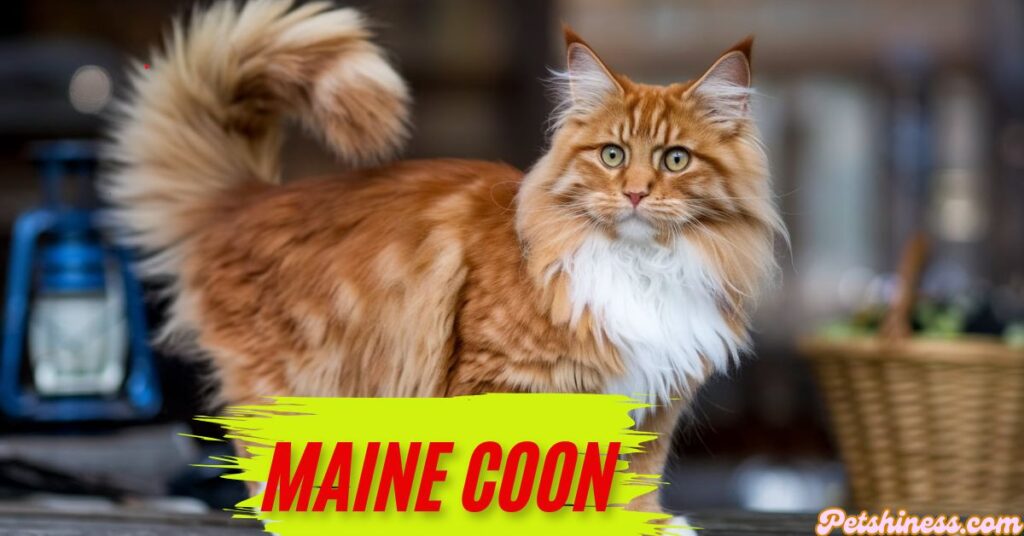
Description: The Maine Coon is one of the largest domestic cat breeds, known for its tufted ears and bushy tail. Their long, silky fur and tufted tips give them an almost wild appearance, and they’re often regarded as the “gentle giants” of the cat world.
Personality: Friendly, playful, and intelligent. Maine Coons are great companions, especially for families with children or other pets.
Grooming Needs: Due to their long fur, Maine Coons require regular grooming to prevent matting and tangling. Brushing 2–3 times a week is ideal.
Norwegian Forest Cat
This breed is large and robust, with thick fur and distinctive tufted ears. The Norwegian Forest Cat was originally bred to withstand cold climates, and its tufts are part of that adaptation.
Personality: Independent, playful, and intelligent. Norwegian Forest Cats are known for being quite social but not overly demanding of attention.
Grooming Needs: Regular grooming is needed due to their dense, water-resistant coat, especially during shedding seasons.
Siberian
Description: The Siberian cat has a thick double coat that provides excellent insulation against cold temperatures. While their ear tufts are not as pronounced as those of the Maine Coon or Norwegian Forest Cat, they still contribute to the breed’s wild and rugged look.
Personality: Friendly, affectionate, and energetic. Siberians are often compared to dogs in their loyalty and playful nature.
Grooming Needs: They have a dense coat that requires moderate grooming, particularly during shedding periods, though they tend to be less prone to matting.
Turkish Angora
Description: Known for their elegant appearance, Turkish Angora cats have long, silky fur and distinctive pointed ear tufts. This breed is recognized for its beauty and agility.
Personality: Active, social, and sometimes even a bit mischievous. They tend to form strong bonds with their human companions and enjoy being the center of attention.
Grooming Needs: Turkish Angoras have fine, long hair that needs regular brushing, but they tend to shed less than other long-haired breeds.
Highlander
Description: The Highlander cat is a relatively new breed that boasts a wild look, with curled tufted ears and muscular build. They are often compared to wildcats due to their appearance.
Personality: Highlanders are known for being playful, affectionate, and curious. They are also quite adaptable and do well in various living situations.
Grooming Needs: Their short to medium-length coat requires moderate grooming, but their unique ears may need extra attention to prevent any buildup of dirt.
Breed Comparison Table
| Breed | Size | Personality | Grooming Needs |
| Maine Coon | Large | Friendly, playful, intelligent | Regular brushing (2–3 times a week) |
| Norwegian Forest Cat | Medium to large | Independent, social, playful | Frequent brushing due to dense coat |
| Siberian | Medium to large | Loyal, energetic, affectionate | Moderate grooming, especially during shedding |
| Turkish Angora | Medium | Active, social, mischievous | Regular brushing, sheds less than other long-haired cats |
| Highlander | Medium to large | Playful, curious, affectionate | Moderate grooming, special care for curled ears |
Wild Cats with Tufts on Ears
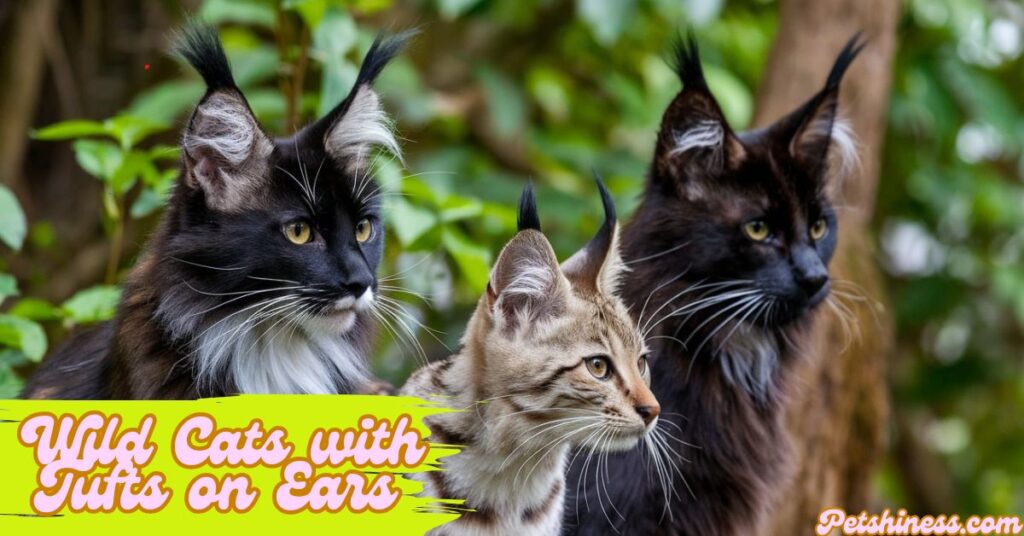
In the wild, ear tufts serve not only as a unique physical feature but also play an important role in enhancing a cat’s survival skills. Many wild cat species, such as the Lynx, Bobcat, and Caracal, are known for having ear tufts, which are primarily found at the tips of their ears. These tufts are thought to have multiple functional benefits, particularly in the wild, where they aid in communication and enhance their hearing abilities.
Lynx-Tipped Ears and Their Functionality
One of the most notable wild cats with ear tufts is the Lynx. Lynxes, including the Canada Lynx and the Eurasian Lynx, are distinguished by the long tufts on their ears, which can grow up to 2 inches. These tufts are not just for show they play an important role in communication and help lynxes detect sound.
The tufts help funnel sound towards the ear canal, aiding in better hearing, especially in dense forests or snowy environments where sound can be muffled. Additionally, these tufts likely provide protection against the cold by keeping snow and debris out of the ears.
Bobcat and Caracal
The Bobcat, another North American wild cat, also has small tufts at the tips of its ears. These tufts help it stay alert in its woodland and desert habitats. While bobcats are more known for their agility and stealth, their ear tufts provide a level of extra sensory perception, useful for locating prey.
The Caracal, a medium sized wildcat found in Africa and parts of the Middle East, has some of the longest ear tufts in the wild cat world. Their distinctive black tufts are thought to assist in communication and may even be used to signal other caracals during mating season. Fun fact: the caracal is also known for its ability to “swat” birds out of the air with incredible precision, aided by their keen hearing facilitated by their ear tufts.
Why Do Some Cats Lack Ear Tufts?
Ear tufts are a fascinating characteristic found in certain cat breeds and wild cats, but not all felines have them. The absence of ear tufts is often tied to genetics and specific breed traits. Understanding why some cats lack these tufts can shed light on how selective breeding and evolution influence a cat’s appearance and characteristics.
Genetics and Breed-Specific Traits
The presence or absence of ear tufts is largely determined by genetics. In certain breeds, ear tufts are a result of specific gene mutations, which are passed down through generations. Cats that lack these mutations simply don’t develop the tufts. Over time, breeders have focused on certain traits to create distinct breed characteristics, and ear tufts are sometimes considered a desirable feature in specific breeds, while others do not emphasize them.
For example, British Shorthairs, known for their round faces and dense coats, do not typically have ear tufts. This is due to the breed’s genetic makeup, which has been selectively bred for traits like a plush coat and a calm temperament rather than the presence of tufts on the ears. The absence of ear tufts in these cats does not affect their health or well-being, as it’s simply a difference in breed characteristics.
Influence of Breeding on Ear Tufts
Selective breeding plays a significant role in whether a breed develops ear tufts or not. Some breeds have been bred for more distinct and functional traits, while others have not had ear tufts included in their genetic design. For example, the Persian breed, known for its long, luxurious coat and flat face, doesn’t have ear tufts. Despite its fluffy coat, the Persian’s ears are smooth and free of tufts.
On the other hand, breeds like the Maine Coon and Norwegian Forest Cat have been specifically bred for environmental survival traits, like thick coats and prominent ear tufts. The tufts in these breeds serve a functional role in the wild, helping with sensory functions, while for other breeds, like the British Shorthair or Sphynx, their characteristics are more about the aesthetic traits that breeders find appealing or suited to their environments.
How to Care for Cats with Ear Tufts
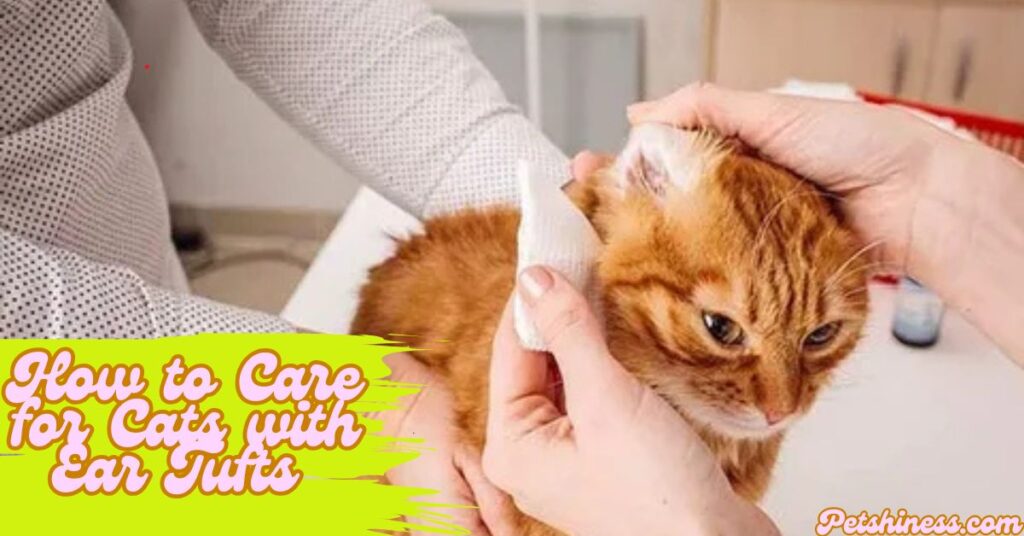
Caring for cats with ear tufts requires a bit of extra attention, especially when it comes to grooming and ear health. Cats with tufted ears, such as the Maine Coon, Norwegian Forest Cat, and Siberian, typically have long, thick fur around their ears, which can be prone to tangling and debris buildup. Here’s how to properly care for them to keep their ears healthy and free of mats.
Grooming Requirements for Long-Haired and Tufted Breeds
Cats with ear tufts often belong to breeds with longer coats, which require regular grooming. Maine Coons and Norwegian Forest Cats need weekly brushing to prevent mats, particularly around the ear area. Brushing not only helps keep their coats sleek but also prevents tangles from forming in the tufts. Siberians, known for their thick coats, also benefit from regular grooming to maintain their fur’s health and texture.
- Use the right tools: Invest in a quality brush or comb designed for long-haired cats. A wide-toothed comb can help detangle mats, while a slicker brush is excellent for preventing tangles.
- Frequency: Brush these cats at least 2-3 times a week to prevent mats, especially around their ears where the tufts are most prominent.
Preventing Mats and Debris Accumulation
One common issue with long-haired cats is matting. The tufts on their ears can trap dirt, pollen, and other debris, leading to uncomfortable mats. To prevent this, it’s essential to regularly inspect their ear tufts and brush away any tangles.
- Ear cleaning: Gently wipe the inner part of the ears with a damp cloth to remove dirt and wax buildup. Be sure to avoid inserting anything into the ear canal. If you notice any strong odor or excessive wax, it could be a sign of infection.
- Routine checks: Pay attention to your cat’s ear tufts, especially if they go outdoors, as these tufts may trap twigs or leaves that can cause irritation.
Ear Health: Checking for Mites, Infections, and Hygiene
Cats with ear tufts are also more vulnerable to ear mites and infections due to their dense ear fur. Regular checks for signs of ear mites or infections are crucial for maintaining your cat’s ear health.
- Signs of mites or infection: Watch for frequent scratching of the ears, redness, excessive ear wax, or a foul odor. These could be indicators of an ear infection or mites.
- Cleaning with care: Use vet-approved ear cleaners to gently clean your cat’s ears. Avoid over-cleaning, as this can irritate the sensitive skin inside their ears.
- Mite prevention: If your cat frequently goes outside or interacts with other animals, consider using a topical medication recommended by your vet to prevent ear mites.
Choosing the Right Cat Breed with Ear Tufts for You
When considering a cat with ear tufts, it’s important to think about how well the breed fits into your lifestyle. Some tufted breeds require more attention and care, while others might be more suited to relaxed or busy households. Here are a few key factors to consider when choosing the right breed for you:
Lifestyle Compatibility (Active vs. Calm Breeds)
Cat breeds with ear tufts vary greatly in their energy levels. For instance, the Maine Coon and Highlander breeds are known for being very active, playful, and sociable, making them a great choice for families or individuals with a lot of time and space for play and interaction. On the other hand, the Norwegian Forest Cat and Siberian are generally more independent but still enjoy socializing, making them a good fit for those who want a somewhat lower-maintenance companion but still appreciate a playful demeanor.
- Maine Coon: Energetic and affectionate, they need plenty of stimulation and enjoy playing with their owners.
- Norwegian Forest Cat: Quiet, calm, and easy-going, they are perfect for people who prefer a more laid-back companion.
- Siberian: Friendly and gentle, but also very active. Great for those who want a mix of playfulness and independence.
If you’re looking for an active cat to keep you entertained, opt for the more lively breeds like the Highlander. If you’re after a calm and independent cat that doesn’t require too much stimulation, consider the Norwegian Forest Cat or Siberian.
Grooming Commitment
Long-haired breeds with ear tufts often require more maintenance in terms of grooming. The Maine Coon and Norwegian Forest Cat, for example, have thick, luxurious coats that need regular brushing to prevent mats, especially around the ears where tufts are more prominent. Siberians, despite their long fur, are known for having less frequent grooming needs due to their water-resistant coat.
- Maine Coon: Needs regular grooming to maintain its beautiful coat and prevent matting.
- Norwegian Forest Cat: Requires weekly brushing, especially during shedding seasons.
- Siberian: A little easier to care for, as their coat tends to mat less frequently.
If you’re willing to invest time in grooming and maintenance, breeds like the Maine Coon are great. However, if you’d prefer a cat with easier grooming demands, the Siberian might be a better option.
Allergies (Hypoallergenic Breeds like Siberian)
For people with allergies, hypoallergenic cat breeds like the Siberian can be a great choice. While no cat is completely hypoallergenic, the Siberian produces fewer allergens compared to other breeds, making it easier for allergy sufferers to live with them. If allergies are a concern, looking for a breed with lower allergen production can significantly improve the experience of living with a cat.
- Siberian: Known for producing fewer allergens, making them a good choice for people with mild allergies.
If you’re sensitive to cat allergens, hypoallergenic breeds like the Siberian are worth considering. They tend to shed less dander and may be easier for those with allergies to tolerate.
How Tufted-Ear Cats Impact Pop Culture
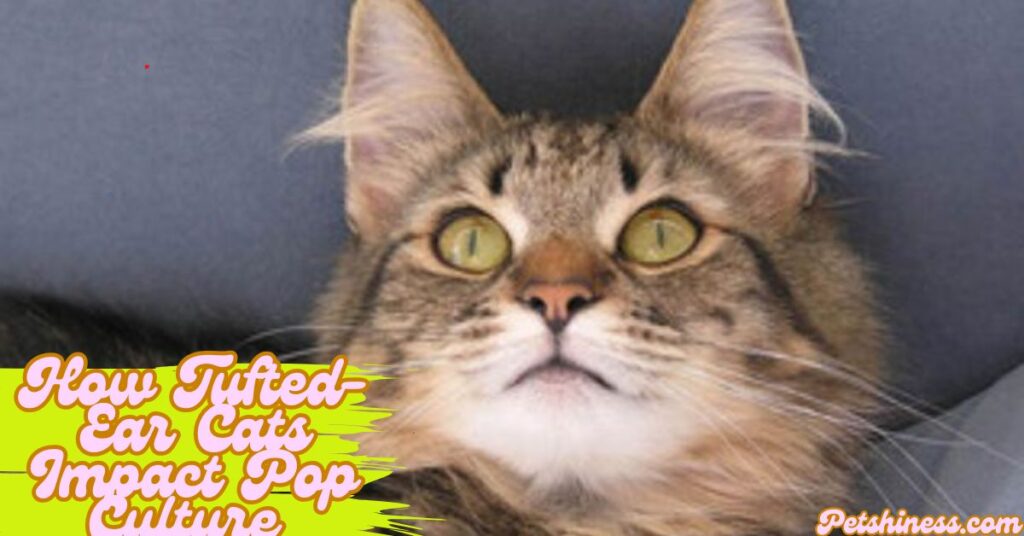
Tufted-ear cats have not only captured the hearts of pet owners but have also made their mark in pop culture. From famous fictional cats to viral social media sensations, these distinctive felines have become a symbol of charm, mystery, and playfulness in the entertainment world.
Famous Fictional Tufted Cats
The most iconic tufted-ear cats are often inspired by wild species, with lions being one of the most recognizable. For example, Disney’s “The Lion King” (1994) showcased lions as noble, tufted-eared creatures.
The lions’ impressive manes and ear tufts contributed to their majestic and powerful image, setting the stage for tufted-eared cats to be seen as regal and fierce in the public imagination. While not all lions in the film had ear tufts, the subtle nod to wild felines made them appear more wild and mysterious, which resonated with audiences worldwide.
In addition, the lynx, known for its tufted ears, has been a common inspiration for fictional wildcats. The “Firestar” character in the Warriors series by Erin Hunter is depicted as a tufted-eared cat, reflecting the beauty and mystery of wild cats with this feature.
Conclusion: Why We Love Cats with Ear Tufts
Cats with ear tufts have an undeniable charm, making them one of the most captivating and unique creatures to keep as pets or admire in the wild. From their evolutionary role in enhancing hearing and camouflage to their distinct, fluffy features, these cats continue to fascinate people around the world.
Whether it’s the regal Maine Coon, the majestic Norwegian Forest Cat, or the wild Lynx, ear tufts not only add beauty but also functionality to a cat’s design. These tufted ears are a symbol of their wild ancestors and a reminder of the incredible adaptability of cats in nature.
As you explore different cat breeds with ear tufts, it’s clear why these felines have found their place in pop culture and everyday life. Their unique looks and quirky personalities make them stand out in both fictional media and viral internet videos. Whether you’re a cat lover or a curious observer, there’s something special about these furry companions.
We’d love to hear from you! Do you have a cat with ear tufts? Share your stories or post pictures of your tufted-eared cats in the comments below. Let’s celebrate these fascinating creatures together!
FAQs About Cats with Ear Tufts
Do all Maine Coons have ear tufts?
No, but ear tufts are a common feature of Maine Coons, enhancing their striking appearance. Not all individuals have prominent tufts, but most do.
Are ear tufts related to a cat’s health?
Ear tufts aren’t health indicators but should be kept clean. Dirty or matted tufts might signal poor grooming or ear issues like infections or mites.
Can you trim ear tufts?
Trimming is not recommended unless necessary. Tufts aid sound detection and temperature regulation. Consult a vet if trimming is unavoidable.
What’s the difference between tufts and furnishings?
Tufts are long hairs at ear tips (e.g., Maine Coons). Furnishings are the dense fur inside the ear, aiding warmth and protection.
Which wild cat has the longest tufts?
The Lynx has the longest ear tufts, up to 2 inches, aiding in sound detection for hunting. Caracals also have prominent tufts but shorter.
Read Related Blogs :
What Is a Female Cat Called
Blue Siberian Kitten Colors, Patterns, and Care Guide
Bengal Tabby Mix : Everything You Need to Know

Jerry John ensures petshiness.com runs smoothly and securely. With a passion for tech and a focus on user experience, Jerry manages the site to deliver top-notch content and functionality.
